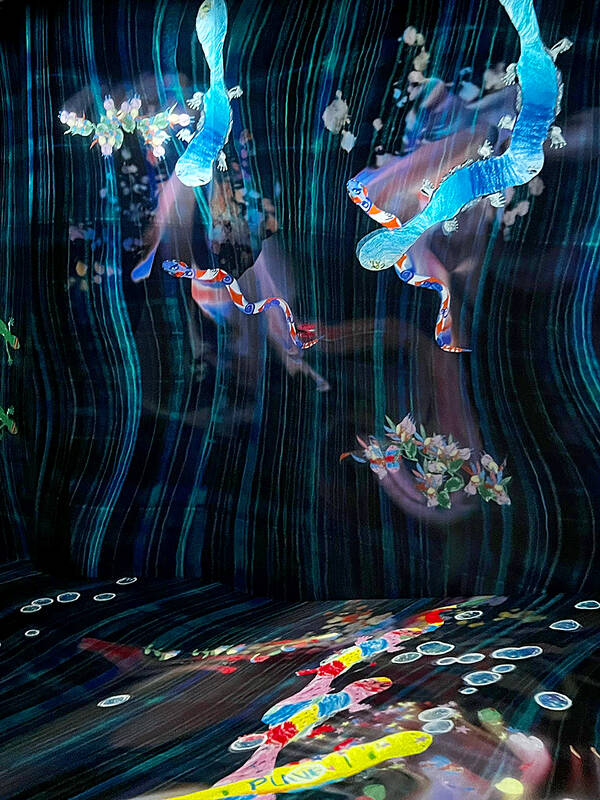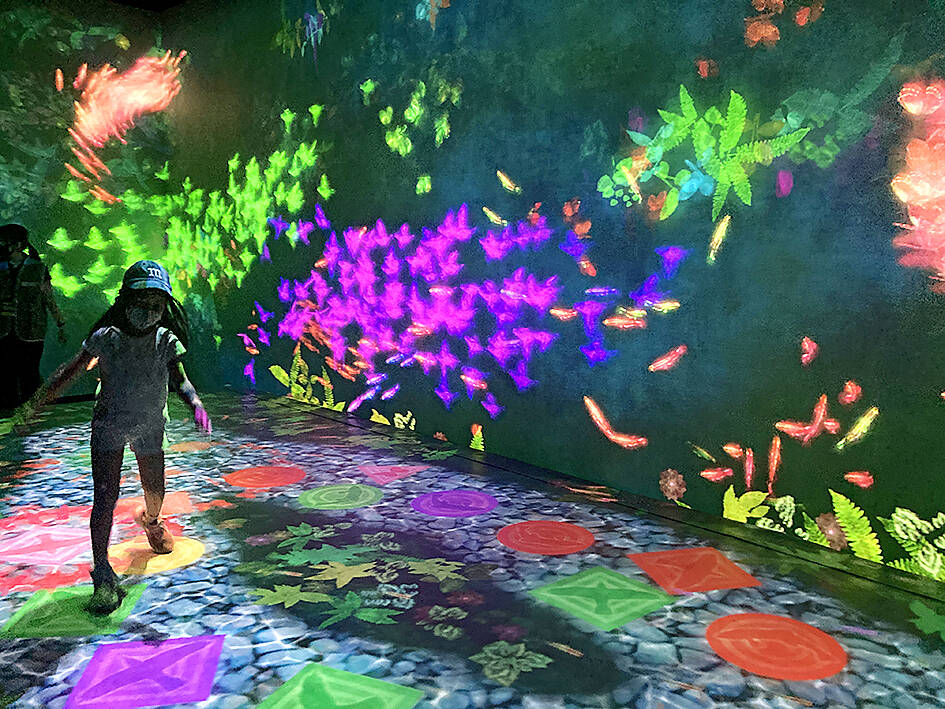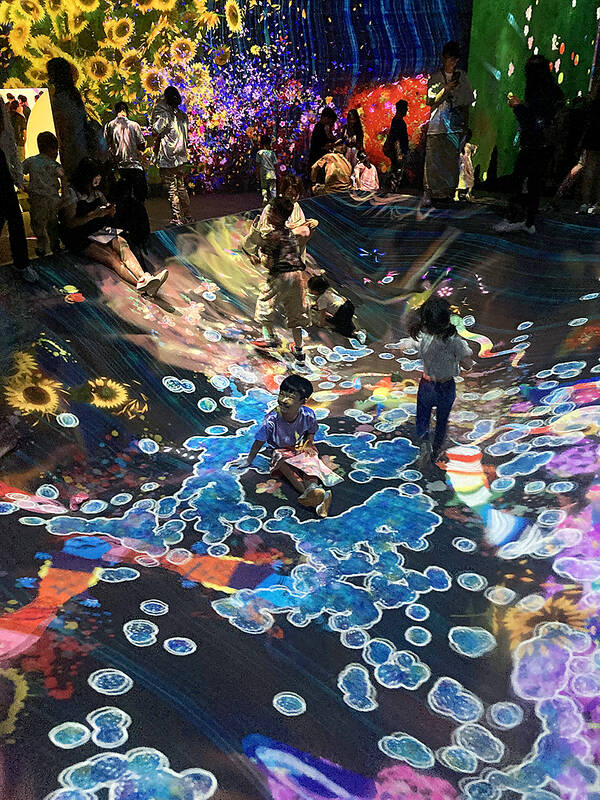Obnoxious camera-wielders block live concerts; cinemas are lit by furious screen tappers; museums become photoshoots; the Mona Lisa has been reduced to a background prop. Were you even there if you didn’t take a picture?
One art exhibition, however, embraces the Instagram of it all. TeamLab art exhibitions allow visitors to interact with playgrounds of light, color and sound as a whimsical photo opportunity.
TeamLab is an international art collective that started in Japan and has expanded globally from Sydney to Saudi Arabia. Their mission: “to navigate the confluence of art, science, technology and the natural world.”

Photo: Hollie Younger
Taipei hosted a teamLab pop-up in 2022, drawing over 300,000 visitors. This year’s exhibition, on view until Oct. 13 at Shilin’s National Taiwan Science Education Center, is a multi-room, multi-sensory feat of engineering and state-of-the-art design that focuses on “collaborative creation (co-creation),” where the guests work together as artists, designing and creating the world around them.
Like the Willy Wonka’s Chocolate Factory of digital art, the floor undulates below, blooming flowers at our footprints; we place our hands on the screens and tiny dancing cartoon people climb up to greet us; melodies symphonize as our bodies bump against glowing orbs in the “Light Ball Orchestra.”
Every motion of every visitor dictates the visual and auditory simulations, creating a trippy, sensory-altering environment so immersive that adults are reduced to the same wide-eyed wonder as their children.

Photo: Hollie Younger
In a darkened alcove, we’re invited to color in an amphibian, butterfly or flower with oil pastels. Staff scan and upload our designs to the art motherboard, and our scribbles instantly enter the third dimension, scuttling and slithering into the main hall.
My rainbow lizard eats my friend’s David Bowie-inspired frog, multiplying and scattering across the walls. The drawings interact symbiotically, squished underfoot or devoured by another doodle further up the food chain, as we chase our group’s salamanders and snakes around the room.
CHILD FRIENDLY

Photo: Hollie Younger
TeamLab is very child-friendly, designed to bring out everyone’s inner child, despite intermittent pleas of weary attendants to “Stop running!” and “Be careful!”
A 20-foot slide of animated fruit and a hop-scotch of stepping stones over a twinkling river attract old and young to whoosh down and leap across.
But while visually stunning, the attraction led me to reflect on the influence of Instagram culture and digital narcissism as much as I appreciated artistic digitalism.
In the main hall, sunflowers bloom across LED screens, ostriches comprised of forget-me-not bouquets dash past, the light undulates purple then blue — and models strike editorial poses for professional cameras; a mother and daughter duo hold up peace signs for a cutesy selfie. Even Kim Kardashian, the Instagram queen herself, has used a Teamlab attraction for a photoshoot.
Another room sees children color in planes, trains and automobiles — then control and observe their movements via tablet devices, eyes once again locked on screens.
One exhibit features inflated beach balls designed to change color and create sound upon organic movement and guest interaction, although visitors seem more concerned with switching them pink for the perfect photo prop.
Ironically, the teamLab Future Park Web site claims that, “large numbers of people are addicted to smartphones. Their brains may be connected, but their bodies are isolated.” But is this social media playground the savior of human connection?
In the 2019 book Advancing Humanity: teamLab’s Borderless World, teamLab founder Toshiyuki Inoko said he dislikes the crowds in front of the Mona Lisa as the art isn’t interactive. Once the space changes with the experiences of others, their existence actually enhances the artwork.
Crowds with cameras are still annoying, pulling visitors out of immersive experiences and into shallower waters. But it makes for fantastic free marketing.
And, admittedly, my Instagram story looked great last weekend.

In the March 9 edition of the Taipei Times a piece by Ninon Godefroy ran with the headine “The quiet, gentle rhythm of Taiwan.” It started with the line “Taiwan is a small, humble place. There is no Eiffel Tower, no pyramids — no singular attraction that draws the world’s attention.” I laughed out loud at that. This was out of no disrespect for the author or the piece, which made some interesting analogies and good points about how both Din Tai Fung’s and Taiwan Semiconductor Manufacturing Co’s (TSMC, 台積電) meticulous attention to detail and quality are not quite up to

April 21 to April 27 Hsieh Er’s (謝娥) political fortunes were rising fast after she got out of jail and joined the Chinese Nationalist Party (KMT) in December 1945. Not only did she hold key positions in various committees, she was elected the only woman on the Taipei City Council and headed to Nanjing in 1946 as the sole Taiwanese female representative to the National Constituent Assembly. With the support of first lady Soong May-ling (宋美齡), she started the Taipei Women’s Association and Taiwan Provincial Women’s Association, where she

It is one of the more remarkable facts of Taiwan history that it was never occupied or claimed by any of the numerous kingdoms of southern China — Han or otherwise — that lay just across the water from it. None of their brilliant ministers ever discovered that Taiwan was a “core interest” of the state whose annexation was “inevitable.” As Paul Kua notes in an excellent monograph laying out how the Portuguese gave Taiwan the name “Formosa,” the first Europeans to express an interest in occupying Taiwan were the Spanish. Tonio Andrade in his seminal work, How Taiwan Became Chinese,

Mongolian influencer Anudari Daarya looks effortlessly glamorous and carefree in her social media posts — but the classically trained pianist’s road to acceptance as a transgender artist has been anything but easy. She is one of a growing number of Mongolian LGBTQ youth challenging stereotypes and fighting for acceptance through media representation in the socially conservative country. LGBTQ Mongolians often hide their identities from their employers and colleagues for fear of discrimination, with a survey by the non-profit LGBT Centre Mongolia showing that only 20 percent of people felt comfortable coming out at work. Daarya, 25, said she has faced discrimination since she